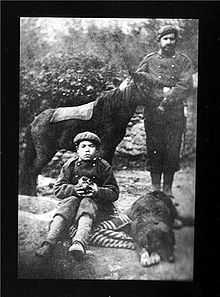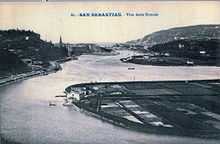Juan Olazábal Ramery
| Juan Olazábal Ramery | |
|---|---|
 | |
| Born |
Juan Olazábal Ramery 1860 Irún, Spain |
| Died |
1937 Bilbao, Spain |
| Nationality | Spanish |
| Ethnicity | Basque |
| Occupation | lawyer |
| Known for | Politician |
Political party | Partido Integrista, Comunión Tradicionalista |
| Religion | Roman Catholicism |
Juan Olazábal Ramery (Irún, 1860 – Bilbao, 1937), was a Spanish Carlist/Traditionalist politician.
Family and Youth

_-_Fonds_Ancely_-_B315556101_A_JACOTTET_2_008.jpg)
Born Juan José León Félix Ramón Olazábal, he was orphaned by his father, Juan Antonio Olazábal Arteaga, at the age of six. Raised by his mother, Prudencia Ramery Zuzuarregui, the young Juan remained influenced by his uncle, Liborio Ramery Zuzuarregui, a public servant and Traditionalist writer. Following a brief stay in France, where the family sought refuge from the Carlist War turmoil, Juan was educated in the Jesuit colleges first at Orduña (Vizcaya) and then in La Guardia (Galicia). Having completed his law studies he returned to the Basque region and settled in San Sebastian, taking posts in the local administration and gradually rising to the position of deputy mayor of the city in 1895.
Public servant

During his career as a public servant Olazábal made himself renowned for defending traditional local establishments of San Sebastian, the Gipuzkoa province and the entire Vascongadas region against the centralising and modernising designs of the national Madrid government. In 1896 he was forced to resign after a failed attempt to block a ministerial legislation he considered detrimental to the interests of the city, but was reinstated following a successful appeal. Early 20th century he helped to set up Liga Foral Autonomista de Guipúzcoa, the organisation pursuing the goal of regional autonomy for the Gipuzkoa province, and later became its second vicepresident. In the aftermath of the ¡Cu-Cut! affair Olazábal sided with the Catalanists against the military and the central government. He was trying to prevent the adoption of the Ley de Jurisdicciones, which would eventually be adopted and place civilians under the military jurisdiction in case of crimes against the country, the army and the national symbols. Having been elected provincial deputy for Irún in 1907 and 1911, he became known nationwide leading the opposition against the so-called Ley de Candado, promoted by the liberal Canalejas government and aimed at restricting the activities of religious orders.
Integrist leader

During his public service Olazábal befriended Ramón Nocedal, the Carlist politician and writer, head of the Partido Católico Nacional and since 1888 the leader of the Integrists, the breakaway faction of the Traditionalists. Heavily influenced by his ideas, in 1897 Olazábal set up in San Sebastian his opus magnum, La Constancia. Diario Integro Fuerista. Published for almost 40 years until 1936, the daily was his political and ideological tribune. Though it has never been a truly nationwide newspaper and remained limited in terms of circulation and geographical coverage, it gradually became an iconic symbol of the conservative Spanish press. La Constancia combined conservative, Catholic monarchism developed as Integrism by Nocedal with the defence of traditional, local Gipuzkoan identity and loyalty.
Briefly served in the Cortes in 1899-1901, elected from Azpeitia (Gipuzkoa); it was then he got engaged in the nationwide politics, representing Integrism in the legislature. Following the death of Nocedal in 1907 Juan Olazábal, together with José Sánchez Marco and Manuel Aznar, took position at the helm of the Integrist party. Two years later he became the sole leader of the organisation. Apart from La Constancia and the parliament, another of his tribunes was El Siglo Futuro, the Madrid-based daily he took over from Nocedal. Founded in 1875 by Candido Nocedal, the newspaper was already a symbol of Traditionalism and Integrism; it would be issued further on until the outbreak of the Spanish Civil War in 1936, continuously edited by Manuel Senante. Probably the most complete account of Olazábal ‘s outlook, combining the Integrist ideology with the Basque leaning, is contained in Liquidando cuentas. Cuestiones candentes que interesan a todos los vascos, published in 1918. During the following years, including the Primo de Riviera dictatorship, he continued to re-emphasize the message as presented in the book.
The Republic

After the fall of the monarchy of Alfonso XIII and the proclamation of the Republic in 1931, Olazábal’s somewhat declining activity was reinvigorated. Profoundly and fundamentally hostile towards democracy and the new regime, and especially deploring the advent of militantly secular republicans and mass workers’ movements, he embarked on the resilient press campaign. This cost El Siglo Futuro and La Constancia periodical administrative suspensions; also Olazábal himself spent three days in jail and was released on bail.
Differences between the existing Carlist factions were dwarfed by the rise of new, radical political enemies on the Left. The Integrists and other Traditionalist organisations were drawn together, which resulted in the merger talks. Finally, in 1932 Olazábal decided to terminate almost half-a-century-long break and agreed to the Integrists entering Comunión Tradicionalista, the new, united Carlist organisation. Within its ranks the former Integrists remained a very influential group, especially that by means of a new publishing house, Editorial Tradicionalista, they continued to control El Siglo Futuro. Because of his age, within the Carlist community of mid-1930s Juan Olazábal was a mentor and moral authority rather than a political leader, involved in day-to-day business.
Olazábal, who has always championed the cause of the Vascongadas, was profoundly disappointed by the turn of the Basque autonomous campaign. Deploring the Basque nationalism as embodied by the PNV, he denounced the initial autonomy draft, produced by the Academy of Basque Studies, as godless. Also the amended version, called the Estella Statute, was regarded by Olazábal as anti-religious. Moreover, he criticised the unitarian nature of the autonomy, which was against his vision of separate regulations for every province. As a result, he labelled the proposal unforal, it is running not in line with, but against the traditional local laws. Within the Carlist community he and Victor Pradera led the anti-autonomy group, as opposed to the pro-autonomy Carlists represented by José Luis Oriol and Marcelino Oreja. The divided Carlists have finally refrained from taking a clear political stance, which has eventually contributed to the failure of the autonomy project.
The Civil War

When the Civil War broke out Olazábal was in Bilbao, within the Republican zone. La Constancia was closed. Unlike a fellow Carlist Esteban Bilbao Olazábal was not kept in the Altuna Mendi prison ship and was instead detained in the Angeles Custodios city prison. Since the Basque government refused to deploy autonomous police to protect the building during the unrest, caused by the nationalist bombing raid over the city in February 1937, the prison was entrusted to the UGT militia unit. The socialist militiamen executed 96 prisoners; some were killed by hand grenades thrown into the cells, some were shot and some were reportedly slashed with the machetes. It is not clear how exactly Juan Olazábal died.
Legacy
In the historical or political public discourse of today’s Spain Juan Olazábal Ramery is largely absent. He remains known mostly to the students of conservative Christian political doctrines in general, and Integrism in particular. He is usually referred to as an heir to Ramon Nocedal and probably remains the second best-known Integrist politician. Few streets in Spain are named after him.
See also
References
- Martin Blinkhorn, Carlism and Crisis in Spain 1931-1939, Cambridge 1975, ISBN 978-0-521-20729-4
- Evarist Olcina, El Carlismo y las autonomías regionales, Madrid 1974, ISBN 84-299-0053-5
- J.N. Schumacher, Integrism. A Study in XIXth Century Spanish politico-religious Thought, "The Catholic Historical Review", XLVIII, 1962-1963, pp. 343–364
- J. Madiran, L`intégrisme. Histoire d`une histoire, Paris 1964
External links
- Juan Olazabal on euskomedia
- Estella Statute text
- Liga Foral declaration
- death of Juan Olazabal
- [http://www.congreso.es/portal/page/portal/Congreso/Congreso/SDocum/ArchCon/SDHistoDipu/SDIndHistDip?_piref73_1340024_73_1340023_1340023.next_page=/wc/servidorCGI&CMD=VERLST&BASE=DIPH&FMT=DIPHXD1S.fmt&DOCS=1-1&DOCORDER=FIFO&OPDEF=Y&NUM1=&DES1=&QUERY=%2881670%29.NDIP. Historical Index of Deputies 1899]
- Olazabal family explained